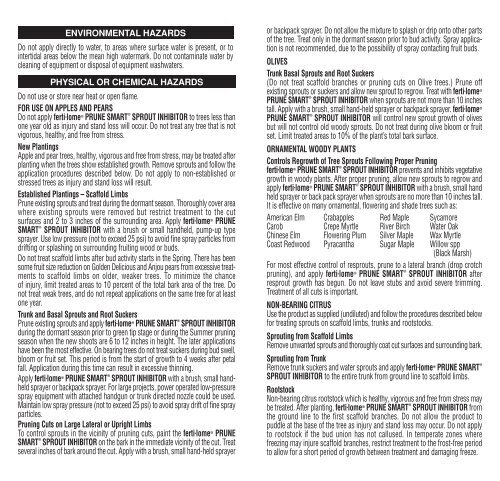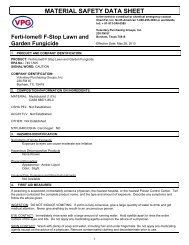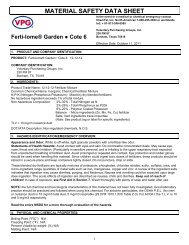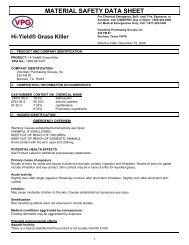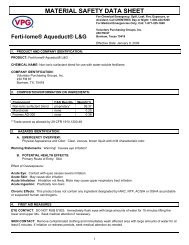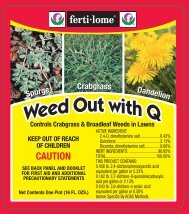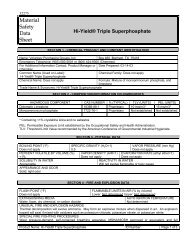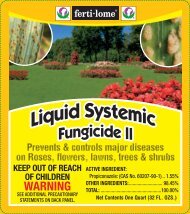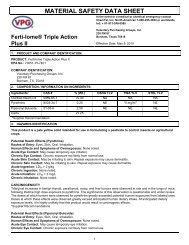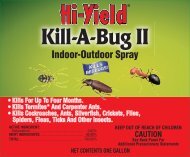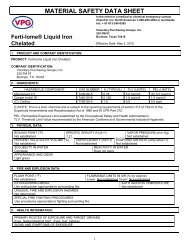SPROUT INHIBITOR SMART SPROUT INHIBITOR - Fertilome
SPROUT INHIBITOR SMART SPROUT INHIBITOR - Fertilome
SPROUT INHIBITOR SMART SPROUT INHIBITOR - Fertilome
You also want an ePaper? Increase the reach of your titles
YUMPU automatically turns print PDFs into web optimized ePapers that Google loves.
10950_FL_lth_1up 11/8/06 1:38 PM Page 2<br />
ENVIRONMENTAL HAZARDS<br />
Do not apply directly to water, to areas where surface water is present, or to<br />
intertidal areas below the mean high watermark. Do not contaminate water by<br />
cleaning of equipment or disposal of equipment washwaters.<br />
PHYSICAL OR CHEMICAL HAZARDS<br />
Do not use or store near heat or open flame.<br />
FOR USE ON APPLES AND PEARS<br />
Do not apply ferti lome • ® PRUNE <strong>SMART</strong> ® <strong>SPROUT</strong> <strong>INHIBITOR</strong> to trees less than<br />
one year old as injury and stand loss will occur. Do not treat any tree that is not<br />
vigorous, healthy, and free from stress.<br />
New Plantings<br />
Apple and pear trees, healthy, vigorous and free from stress, may be treated after<br />
planting when the trees show established growth. Remove sprouts and follow the<br />
application procedures described below. Do not apply to non-established or<br />
stressed trees as injury and stand loss will result.<br />
Established Plantings – Scaffold Limbs<br />
Prune existing sprouts and treat during the dormant season. Thoroughly cover area<br />
where existing sprouts were removed but restrict treatment to the cut<br />
surfaces and 2 to 3 inches of the surrounding area. Apply ferti lome • ® PRUNE<br />
<strong>SMART</strong> ®<br />
<strong>SPROUT</strong> <strong>INHIBITOR</strong> with a brush or small handheld, pump-up type<br />
sprayer. Use low pressure (not to exceed 25 psi) to avoid fine spray particles from<br />
drifting or splashing on surrounding fruiting wood or buds.<br />
Do not treat scaffold limbs after bud activity starts in the Spring. There has been<br />
some fruit size reduction on Golden Delicious and Anjou pears from excessive treatments<br />
to scaffold limbs on older, weaker trees. To minimize the chance<br />
of injury, limit treated areas to 10 percent of the total bark area of the tree. Do<br />
not treat weak trees, and do not repeat applications on the same tree for at least<br />
one year.<br />
Trunk and Basal Sprouts and Root Suckers<br />
Prune existing sprouts and apply ferti lome • ® PRUNE <strong>SMART</strong> ® <strong>SPROUT</strong> <strong>INHIBITOR</strong><br />
during the dormant season prior to green tip stage or during the Summer pruning<br />
season when the new shoots are 6 to 12 inches in height. The later applications<br />
have been the most effective. On bearing trees do not treat suckers during bud swell,<br />
bloom or fruit set. This period is from the start of growth to 4 weeks after petal<br />
fall. Application during this time can result in excessive thinning.<br />
Apply ferti lome • ® PRUNE <strong>SMART</strong> ® <strong>SPROUT</strong> <strong>INHIBITOR</strong> with a brush, small handheld<br />
sprayer or backpack sprayer. For large projects, power operated low-pressure<br />
spray equipment with attached handgun or trunk directed nozzle could be used.<br />
Maintain low spray pressure (not to exceed 25 psi) to avoid spray drift of fine spray<br />
particles.<br />
Pruning Cuts on Large Lateral or Upright Limbs<br />
To control sprouts in the vicinity of pruning cuts, paint the ferti lome • ® PRUNE<br />
<strong>SMART</strong> ® <strong>SPROUT</strong> <strong>INHIBITOR</strong> on the bark in the immediate vicinity of the cut. Treat<br />
several inches of bark around the cut. Apply with a brush, small hand-held sprayer<br />
or backpack sprayer. Do not allow the mixture to splash or drip onto other parts<br />
of the tree. Treat only in the dormant season prior to bud activity. Spray application<br />
is not recommended, due to the possibility of spray contacting fruit buds.<br />
OLIVES<br />
Trunk Basal Sprouts and Root Suckers<br />
(Do not treat scaffold branches or pruning cuts on Olive trees.) Prune off<br />
existing sprouts or suckers and allow new sprout to regrow. Treat with ferti lome • ®<br />
PRUNE <strong>SMART</strong> ® <strong>SPROUT</strong> <strong>INHIBITOR</strong> when sprouts are not more than 10 inches<br />
tall. Apply with a brush, small hand-held sprayer or backpack sprayer. ferti lome • ®<br />
PRUNE <strong>SMART</strong> ® <strong>SPROUT</strong> <strong>INHIBITOR</strong> will control new sprout growth of olives<br />
but will not control old woody sprouts. Do not treat during olive bloom or fruit<br />
set. Limit treated areas to 10% of the plant’s total bark surface.<br />
ORNAMENTAL WOODY PLANTS<br />
Controls Regrowth of Tree Sprouts Following Proper Pruning<br />
ferti lome • ® PRUNE <strong>SMART</strong> ® <strong>SPROUT</strong> <strong>INHIBITOR</strong> prevents and inhibits vegetative<br />
growth in woody plants. After proper pruning, allow new sprouts to regrow and<br />
apply ferti lome • ® PRUNE <strong>SMART</strong> ® <strong>SPROUT</strong> <strong>INHIBITOR</strong> with a brush, small hand<br />
held sprayer or back pack sprayer when sprouts are no more than 10 inches tall.<br />
It is effective on many ornamental, flowering and shade trees such as:<br />
American Elm Crabapples Red Maple Sycamore<br />
Carob Crepe Myrtle River Birch Water Oak<br />
Chinese Elm Flowering Plum Silver Maple Wax Myrtle<br />
Coast Redwood Pyracantha Sugar Maple Willow spp<br />
(Black Marsh)<br />
For most effective control of resprouts, prune to a lateral branch (drop crotch<br />
pruning), and apply ferti lome • ® PRUNE <strong>SMART</strong> ® <strong>SPROUT</strong> <strong>INHIBITOR</strong> after<br />
resprout growth has begun. Do not leave stubs and avoid severe trimming.<br />
Treatment of all cuts is important.<br />
NON-BEARING CITRUS<br />
Use the product as supplied (undiluted) and follow the procedures described below<br />
for treating sprouts on scaffold limbs, trunks and rootstocks.<br />
Sprouting from Scaffold Limbs<br />
Remove unwanted sprouts and thoroughly coat cut surfaces and surrounding bark.<br />
Sprouting from Trunk<br />
Remove trunk suckers and water sprouts and apply ferti lome • ® PRUNE <strong>SMART</strong> ®<br />
<strong>SPROUT</strong> <strong>INHIBITOR</strong> to the entire trunk from ground line to scaffold limbs.<br />
Rootstock<br />
Non-bearing citrus rootstock which is healthy, vigorous and free from stress may<br />
be treated. After planting, ferti lome • ® PRUNE <strong>SMART</strong> ® <strong>SPROUT</strong> <strong>INHIBITOR</strong> from<br />
the ground line to the first scaffold branches. Do not allow the product to<br />
puddle at the base of the tree as injury and stand loss may occur. Do not apply<br />
to rootstock if the bud union has not callused. In temperate zones where<br />
freezing may injure scaffold branches, restrict treatment to the frost-free period<br />
to allow for a short period of growth between treatment and damaging freeze.


